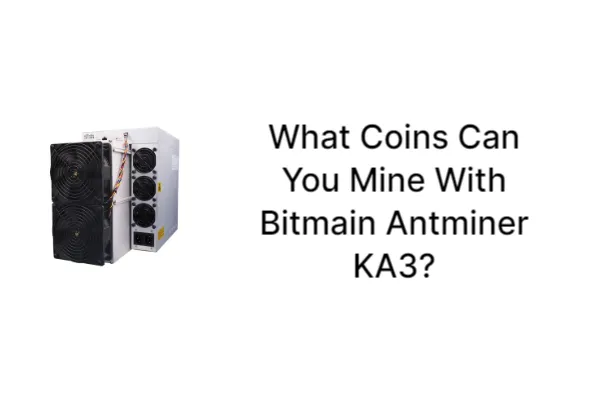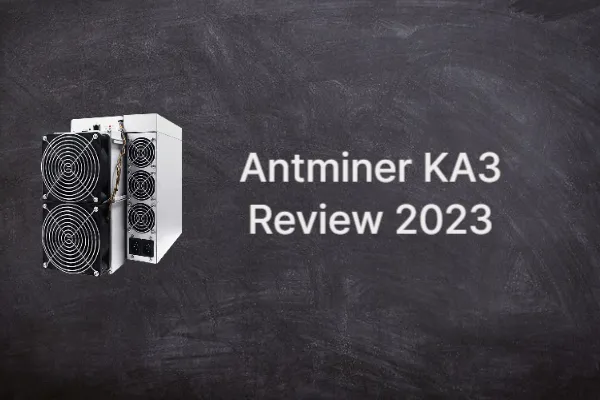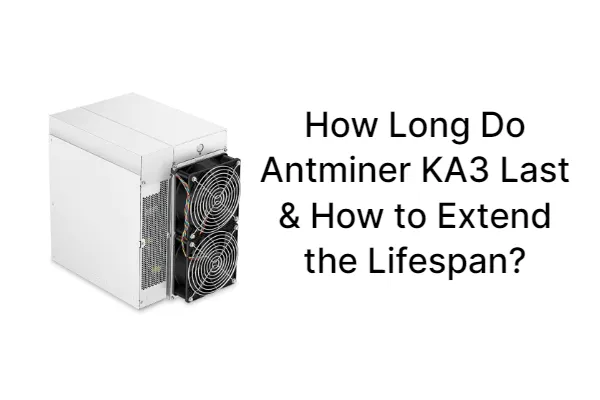In addition to providing cleaning instructions for Antminer KA3 miners, this article discusses the ideal mining rig operating conditions. Knowing how to perform preventative maintenance is essential for ensuring stable hashing performance and a longer miner lifespan.
The first section provides guidance on how to operate a miner on a daily basis, and the final section provides a list of recommended equipment. In the second section, which is devoted to cleaning, we list some of the supplies you may need. We wrap up by offering some basic tips for troubleshooting the Antminer KA3 and details on how to get in touch with the manufacturer or other miners for assistance or repairs.
Table of Contents
Antminer KA3 Daily Operation Tips

A Bitmain Antminer KA3 miner needs to be monitored at least every couple hours.
What should you be on the lookout for when using Antminer KA3?
- Antminer KA3 machine’s average hashing speed is within 5-10% of the stated specs
- Antminer KA3 miner’s chip temperature is preferably between 70°-80°C (158°-176°F) to preserve the ASICs
- The ambient (room) temperature is 10°-30°C (50°-86°F) for optimal hashing
- The PCB (hash/control board) temperature is less than ~ 90°C (194°F), and all three hash boards do not differ more than 10°C (~20°F) from one another
- Antminer KA3 pool latency is low, and your submitted hashing speed matches the kernel log
- The electricity supply of Antminer KA3 is stable and cables are not damaged
- The Antminer KA3 machine fans and the room ventilation is not obstructed
In the event that any of the problems mentioned in these bullet points appear, you must troubleshoot. Sometimes performing a lengthy reset (turning the machine off for two minutes) or moving the machine to improve airflow can be beneficial. A thorough investigation is sometimes required. The troubleshooting and repairs sections of this article are expanded upon at the end.
Here is more detailed information regarding Antminer KA3 running conditions:
Visual Checks for Antminer KA3
Perform a visual inspection on the Antminer KA3 miner before installation or following repairs.
- Inspect for dents or damage
- Gently shake and listen for Antminer KA3 loose screws, heat sinks, or other components
- Check that no scraps are lodged in the fans, and they are complete, and run in the correct direction
- Feel for loose cables, and check that Antminer KA3 copper bars are not tilted or squished
- If you need to touch the electronics, wear antistatic gloves
- See that no warning lights come on when it is plugged in
- Double-check that your Antminer KA3 mining pool settings and IP are correct
Fans of Antminer KA3
When the cooling fans on your Antminer KA3 miner eventually need to be replaced, it is advised to use the same brand that the miner’s original manufacturer used. To reduce noise or improve equipment cooling, some miners decide to upgrade their fans to better models. However, they should be aware that doing so may result in decreased power usage and efficiency. To prevent overheating, avoid replacing a high speed fan with a lower speed one.
Ventilation and Humidity of Antminer KA3
Mining rigs like the Antminer KA3 get hot. A mining space’s ability to dissipate heat can be improved by adding room fans and/or outside ventilation. Installing a dust screen or mesh on an intake vent will prevent bugs from entering your mining room. The proper airflow is maintained by preventing backdraft with the aid of a wind cover or hood on an outlet vent. Just remember to regularly inspect and maintain the Antminer KA3 ventilation systems. Additionally, make sure your ventilation is not letting snow or rain in.
Mining farms can also create distinct hot and cold aisles and install negative pressure fans to stop warm air from recirculating into the cooler air intake area. Some farms are built in the shape of a cathedral, which pushes hot air up and through roof vents while pulling cool air up through the sides of the structure. The alternative is to draw cooling air directly through the mining containers from one side to the other.
Air conditioning is typically not cost-effective because it has a high operating cost. Although they are not failsafe systems, some miners opt to use water curtains instead. They have the potential to evaporate a lot of water and clog filters with dust and other debris. Furthermore, the presence of water curtains may increase humidity.
If there is a lot of humidity present, an Antminer KA3 miner may corrode, leaving pitting and bubbling on the metal surfaces. Optimal humidity is below 65%. This issue can be resolved using dehumidifiers or air recirculation. Additionally, operating equipment near the ocean is not recommended because the salty air can harm hash boards.
Noise of Antminer KA3
With a sound level of about 70 dB, Antminer KA3 mining equipment is noisy. The good news is that bitcoin miners are incredibly innovative and creative when it comes to finding solutions to noise problems.
A miner silencer box, for instance, can be made out of metal, wood, or even an ice chest. When testing a new miner box, pay attention to the machine’s temperature and make adjustments as needed to avoid overheating. A mining box or room could also be made quieter by using rockwool, a fireproof, soundproof insulation material.
Lastly, wear ear protection around running Use Antminer KA3 equipment to protect your hearing.
Immersion

An alternative to running on air, immersion fluid can be used to cool Antminer KA3 miners, lessen noise, and keep the machinery cleaner. The lifespan of a rig might also be extended by immersion. Some miners managed to connect the heating systems for their homes and swimming pools despite being submerged!
However, not everyone would benefit from this type of solution due to its potential costs, demands, and voiding of warranties. Immersion systems use a lot of water because they dissipate heat into a cooling chamber in hot climates where water evaporates quickly. In addition, corrosion can be exacerbated by immersion fluids, particularly mineral oil. Damage has been linked to sulphur, bubble patterns, and insufficient electrical grounding in research studies.
The only company that makes specialized immersion cooling systems and units is Canaan, a producer of mining equipment for the Antminer KA3.
Fire Safety
To reduce the chance of a fire, use non-flammable products close to your machine. Don’t forget to keep a fire extinguisher nearby and make sure you have enough ventilation. You should clean your Antminer KA3 miner frequently to prevent dust buildup that could catch fire. The following section discusses how to clean your Antminer KA3 miner.
Utilize network and electrical cables that are fireproof in your setup. Regularly inspect cables for damage, and replace them as necessary. You can also use an infrared thermometer to check that the temperature of the circuit breaker, cables, and power distribution unit (PDU) connectors are not heated above 70°C (158°F). Additionally, pay attention to the following stability of your electricity supply.
Electricity Checks
Make sure the proper electrical setup is in place before starting a mining operation. You will need to do your own research based on the model(s) you wish to run, and may need to hire an electrician to get started. Furthermore, a power supply must be roughly 20% more potent than the miner’s specified power consumption.
On a daily basis you can use a multimeter to check that the voltage of the PDU sockets are within the typical range of 220V plus 10% to prevent instability or burned cables. In addition, confirm that no three-phase ammeter you own deviates by more than 15%. In the event that the voltage is unusual, get in touch with an electrician.
You should also routinely check for electrical leaks coming from miners. If you are receiving shocks when you touch your miner or its power supply unit (PSU), the equipment may not be properly grounded, which could damage it.
Avoid power spikes and outages because they can damage equipment. This can be accomplished by either installing surge protectors or by turning off your machines during storms out of an abundance of caution. Additionally, you should slowly shut down your devices rather than abruptly. The last thing to do is to make sure that none of your power outlets are corroded, hot, or loose.
Network
Use a static IP and a router to isolate your Antminer KA3 miners. This ensures a secure network with adequate speed. Many people also use a VPN and/or TOR for additional obfuscation, but this can add latency. Your daily earnings may decrease as a result of fluctuating hash rate shares. These problems can also be brought on by slow networks or a pool connection with a high latency. Your Antminer KA3 line speed can be checked by pinging the mining pool from the miner’s network diagnostics interface; it should only take a few hundred milliseconds. Request different Stratum addresses from your mining pool or switch mining pools if your speed is still too slow.

Over, Underclocking, and Autotuning
An automatic adjustment is made to the fan speed in Antminer KA3 miners. For instance, if a machine is running hot, fans’ RPM will increase. Some mining equipment even shuts down if it becomes too hot or cold to prevent damage. And it is primarily because of these stock fan speed and shutoff functions that manufacturers advise against overriding a miner’s settings with third-party firmware.
Various power mode settings are available on some Antminer KA3 machines in the miner configuration setup. The overall voltage of the miner is changed by the manufacturer’s under- and overclocking firmware. Contrarily, it is possible to autotune chips with more complex settings, like lowering the voltage to a specific chain of chips, using third-party firmware from companies like Braiins, VNISH, and others.
Many miners believe that autotuning is particularly helpful for older machines to handle the unstable Antminer KA3 or for home mining. Users should be aware, however, that warranties will be void after using alternative firmware, that poor power supplies can harm chips, and that software can introduce viruses or steal some of your hash. Third-party firmware is also not free and may have security flaws.
Air overclocking will also eventually result in chip burnout, which can be very expensive. On the other hand, as long as chip temperatures remain low, overclocking in immersion fluid should be acceptable. As a result, if you choose to use Antminer KA3 firmware, always do your own research on it. And, it is wise for your own peace of mind to use an electricity usage monitor, to double-check that the miner’s electrical draw at the wall plug matches what a firmware’s UI specifies.
Additionally, farms may make use of outside miner management software. Foreman.mn, for example, is a system that can help with accounting, automating mining operations, lowering miner errors, and more.
Summary of Tools for Miner Operation
In summary, here is a list of some of the suggested tools discussed in this section that you may find useful for your Antminer KA3 mining operation, though you do not necessarily need everything on this list:
- Anti-static gloves
- Ear protection
- A sound/decibel meter
- Soundproofing material is optional
- Vents, storm shelters, dust filters, miner safety equipment, etc. are examples of ventilation equipment.
- Room fans and/or dehumidifiers
- An infrared thermometer, or a room thermometer
- A fire extinguisher and alarm
- Extra cables and miner fans specific to your model
- Installation of a PDU may be needed
- A multimeter, and maybe an ammeter
- A network cable and a router
- An electricity usage monitor/meter
- A computer to view the network, and your miner’s admin and kernel log
- Voltage enhancing firmware from the manufacturer, or from a third-party is optional
Cleaning Your Miner
You must regularly clean your Antminer KA3 miner. As a result, the risk of heat and fire is reduced while efficiency and hash rate are increased. The lifespan of your equipment should be extended and the microchips and other components should be preserved by keeping the machine clean.
Attempt to clean your Antminer KA3 miner once per month, or more frequently if necessary to maintain good air quality. If you can see visible lint or if your typical daily mining speed drops by more than 5%, you will know when it is necessary.
The best way to clean an Antminer KA3 miner is to use a high pressure air compressor with air gun in interval bursts. By doing this, any accumulated dust on the fan blades, chassis, and hash boards will be removed. The acceptable air pressure range is 0.7 MPa plus or minus 0.05 MPa.
You typically do not need to disassemble the machine for routine monthly cleanings, with the exception of humid environments where it is challenging to remove dust with just compressed air. In which case you can take out the hash boards and dismount the fans, and then gently brush them off with a dry antistatic brush.
Vacuums have the potential to suck up or loosen components, so it is not advised for miners to use them on their mining equipment. It is also not recommended to use canned compressed air because it contains water, which could ultimately short out a machine or damage its components.
It’s also essential to keep the mining area clean. Try to vacuum and dust the surfaces around your mining area on a regular basis.
How to Deep Clean An Antminer KA3 Miner
Your Antminer KA3 miner may need to be thoroughly cleaned on occasion, depending on the quality of the air in your operating environment. Once or twice a year, this may take place. At mining farms and repair centres, ultrasonic cleaning machines for electronics are often used. Furthermore, flux-filled ultrasonic baths work wonders for immersion units and for removing solder or other residue left over from Antminer KA3 miners.
For home miners, hash and control boards can be manually rinsed with 99% isopropyl alcohol. It is not advised to use water to clean miners because salts and minerals that could damage your machine and cause short-circuits can be left behind. If your machine were to unintentionally get wet with water from the rain or other liquids, don’t forget to clean it with 99% isopropyl alcohol to remove any residue.
Summary of Tools for Cleaning Your Antminer KA3 Miner
In conclusion, for the monthly clean of your Antminer KA3 miner we recommend the following tools:
- A high pressure air compressor with an air gun; the air pressure range should be 0.7 ±0.05 MPa
- Antistatic gloves
- An antistatic soft brush
- A vacuum cleaner for the surrounding area, and dusting rags
- And remember to clean out your room ventilation filters/mesh, if used
Furthermore, an ultrasonic machine can help to deep clean your in particular if you use immersion, Antminer KA3 miner. Or, here is a list of the equipment required to manually deep clean a bitcoin ASIC miner like in the video above:
- Tools: a small dry antistatic brush and q-tips to remove stubborn dust, a a plastic bath tub and cup for the bath, a net or strainer, a drying line and wire, cloths, and safety gloves.
- Substances: 99% isopropyl alcohol, The fan grill needs to be cleaned with vinegar, the outer case only with Never Dull polish, and the fan hub with WD40.
- Parts: replacement cables and/or fans may be needed which suit your ASIC model.
To protect the parts of the rig, be careful not to overly force or use harsh brushes when cleaning the Antminer KA3!



